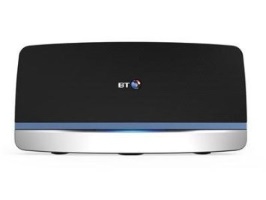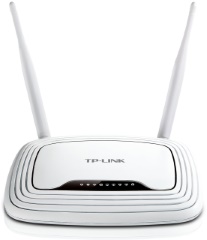tl;dr It is straight forward to connect a second Ethernet WAN modem/router/AP to a BT home hub (or other primary router) and configure it as a separate, independent LAN (TCP/IP subnet). A 3rd Wireless AP/Router can then used as a Wi-Fi client (or alternatively a bridge) to extend the secondary LAN over an air gap.
My home office has had its own dedicated copper telephone line and LAN/Wi-Fi since I started working from home. While having a dedicated line makes accounting a little simpler, I almost never use never use the phone as I have my mobile and also a wireless DECT connection to the home line. Since we moved the home line to BT Infinity fibre broadband (currently running at an uncapped 75/20Mbs) the home LAN has been much faster than the very cheap ISP office package from TalkTalk Business. I have thus been thinking of sharing the home network for work and dropping the office line completely. The home LAN use is not yet heavy enough that I need to worry too much about contention, though this might well change with 2 teenagers at home.
If sharing the BT line was to be successful I wanted to somehow keep the home and office LANs quite separate. In addition the office is separated from the house by a physical gap of about 3m and I didn’t particularly want to run a rugged Ethernet cable across the gap, preferring a wireless solution.
After a bit of research I’ve now got a very acceptable solution with separate LANs and full line speed available in office (most of the time). I upgraded the BT Infinity to uncapped speed and usage and negotiated a free Home Hub 5 to replace the old 3rd edition we’ve had since Infity became available. The Home Hub 5 is an excellent piece of kit, supporting 802.11ac for maximum Wi-Fi speed. I did debate using this for the office network and a Wi-Fi connection to it is always an option, though the 5GHz transmitter doesn’t reach the office.
After research and being very happy with a recently acquired TP-link Wi-Fi dongle, I broke with my long standing Netgear tradition and purchased two TP-Link TL-WR843ND Ethernet WAN modem routers. These have 300Mbs 802.11b/g/n Wi-Fi support (an Ethernet WAN connects to a cable modem rather than a copper phone line as with ADSL devices).
These TP-Link devices have 2 useful enhancements over the cheaper TL-WR841ND. For one, the Power over Ethernet feature makes it easy to place the device without worrying about the availability of a near-by power outlet. Secondly, it has a WISP mode designed for connection to wireless ISPs and I felt this might work well as an alternative to the usual Wi-Fi bridge arrangement to extend LANs via Wi-Fi which these devices also explicitly support (and it does).
So in outline the configuration steps I performed are as follows:
1) Set up one TL-WR843ND in router mode (the default is WISP mode) with the WAN connection type set to dynamic IP (as the Home hub provides DCHP). Set it’s LAN IP address to 192.168.2.1 (it’s own DHCP server will update to match). This puts it on a different subnet to both the Home Hub and the office network.
Connect it’s Ethernet WAN input to a BT Home Hub LAN socket. This then works as a second router/AP but will be dedicated to connecting to the other TL-WR843ND via W-Fi to extend the office LAN (though you could always us it as a normal AP as well). I turned off the SSID broadcast to make connections less likely. The home network uses the Home Hub as usual.
2) Configure the 2nd TL-WR843ND in WISP mode to access the first AP you set up above and use it as the office router/AP. Use the router’s quick setup option and/or the Survey button to find the first AP. This then provides wired and Wi-Fi access to office equipment. Use a different WIF SSID to the other TL-WR843ND and perhaps manually set the channel to be different to the BT Home Hub 2.4GHz channel rather than auto mode (I used Ch 1 for the Home Hub and 13 for the APs).
Notes:
1) I had to manually set the Wi-Fi region on both routers to UK as it defaults to US.
2) A bug in the WISP mode of the TL-WR843ND means it assumes American Wi-Fi channels for the WAN. So, the first AP will not be not seen by the WAN Survey button if it is on channel 12/13 . The solution is to initially switch to router mode and change to UK region.
3) The office network connects via the the BT Home Hub which is possibly less reliable; should the Hub fail both home and office networks will go down. It should be possible to swap the 2 routers so the Hub connects via the TL-WR843ND. While I proved the TL-WR843ND works when connected directly to the fibre modem instead of the Home Hub, I did not check if the Home Hub has appropriate settings to work as the secondary router (I think not). I may need to revisit this if I hit problems going through the 2 routers, eg when hosting a website or needing port forwarding.
4) In theory it should be possible to connect both routers to the fibre modem. However the BT supplied ECI modem is locked so only the LAN1 socket works. It is possible to unlock the modem with special hardware but I did not want to go down this route.
5) I learnt the fickleness of W-Fi as when testing wireless access to the 1st router as I only got 20Mbs with my Dell XPS 12 laptop which got a full 75Mbs with the BT Home Hub. Having checked everything was the same and proving wired access was full speed, I tried the Wi-Fi access from other devices. Needless to say the TP-Link dongle work best and I got mixed results from other devices. I can only assume some strange incompatibility with the XPS Wi-Fi
6) As the WISP client mode worked perfectly well I didn’t try the Wi-Fi bridging mode. I’ve not idea if one mode is more efficient that the other.
7) When setting up the the routers don’t forget to set strong passwords and encryption.



How did you manage to change WiFi channel when in WISP mode?
I can’t change this on mine… for me the channel stays the same as the WISP WiFi is using – which is not optimal for best performance.
I can’t recall, but it might have been to set up the ‘broadcast’ end first and then the ‘receiver’ followed. I certainly dug around all the options.